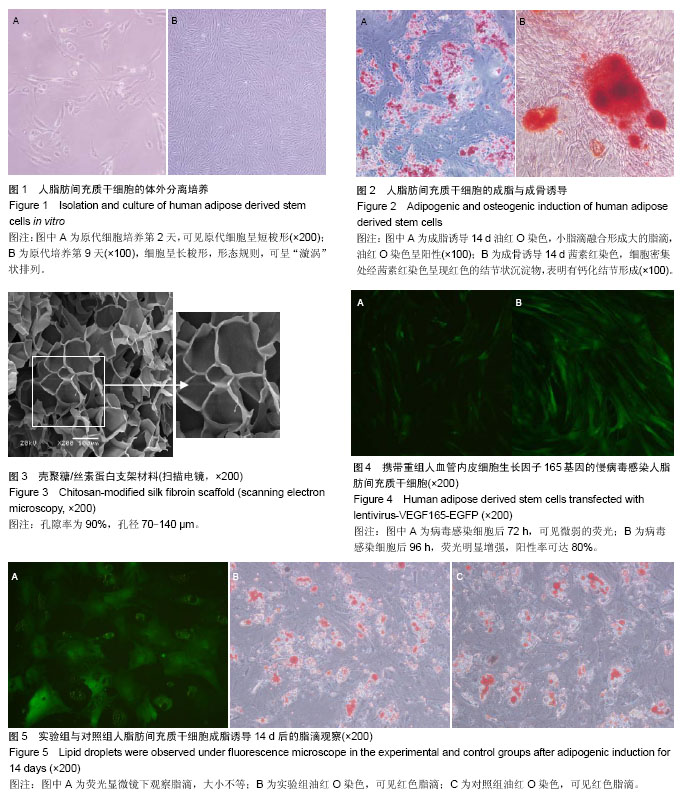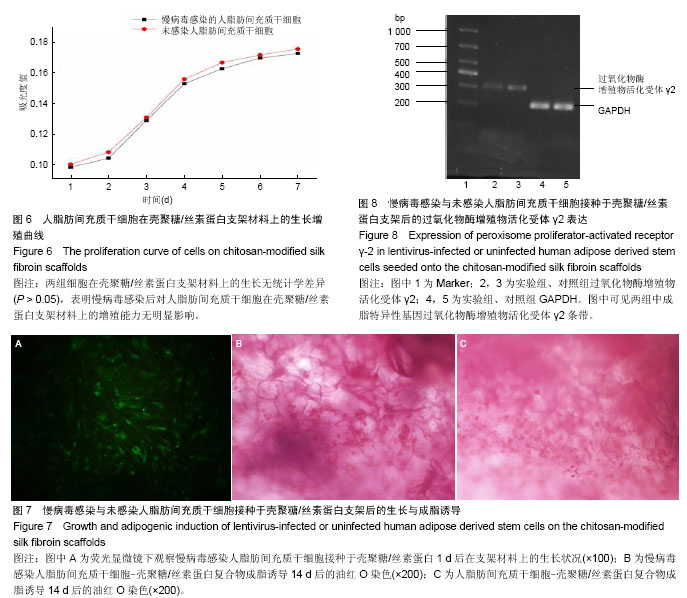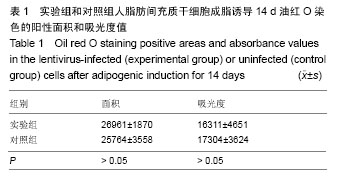中国组织工程研究 ›› 2014, Vol. 18 ›› Issue (52): 8450-8455.doi: 10.3969/j.issn.2095-4344.2014.52.016
• 材料力学及表面改性 material mechanics and surface modification • 上一篇 下一篇
改性丝素蛋白支架与生长因子基因修饰脂肪间充质干细胞构建组织工程脂肪
亢 婷1,王 刚2,刘 毅2,刘刚强2
- 1兰州大学第二临床医学院,甘肃省兰州市 730061;2解放军兰州军区兰州总医院全军烧伤整形外科中心,甘肃省兰州市 730050
In vitro construction of tissue engineered adipose using vascular endothelial growth factor 165 gene-modified human adipose derived stem cells with chitosan-surface modified silk fibroin scaffolds
Kang Ting1, Wang Gang2, Liu Yi2, Liu Gang-qiang2
- 1Lanzhou University Second Hospital, Lanzhou 730061, Gansu Province, China; 2Military Institute of Burns and Plastic Surgery, Lanzhou General Hospital of Lanzhou Military Region, Lanzhou 730050, Gansu Province, China
摘要:
背景:构建工程化的脂肪组织,适宜的种子细胞和性能优良的支架材料缺一不可。
目的:探讨携带重组人血管内皮细胞生长因子165基因的慢病毒载体感染人脂肪间充质干细胞后,与壳聚糖修饰的丝素蛋白支架材料体外构建组织工程脂肪的可行性。
方法:选取生长良好的第3代人脂肪间充质干细胞,用携带重组人血管内皮细胞生长因子165基因的慢病毒进行感染。将慢病毒感染与未感染的第3代人脂肪间充质干细胞成脂诱导14 d,油红O染色观察细胞的成脂能力;将慢病毒感染和未感染的第3代人脂肪间充质干细胞分别接种于壳聚糖修饰丝素蛋白支架材料上,MTT法检测细胞增殖能力;成脂诱导14 d后进行油红O染色,RT-PCR检测成脂特异性基因过氧化物酶增殖物活化受体γ2的表达。
结果与结论:成脂诱导14 d后,慢病毒感染与未感染的第3代人脂肪间充质干细胞均可见成熟脂肪细胞,组间差异不明显。慢病毒感染和未感染的第3代人脂肪间充质干细胞在改性丝素蛋白支架的生长曲线相近;成脂诱导后,油红O染色及RT-PCR均显示生成大量成熟脂肪细胞。表明携带重组人血管内皮细胞生长因子基因的慢病毒感染人脂肪间充质干细胞后,不影响其生长及成脂能力,与壳聚糖修饰的丝素蛋白支架材料可成功构建组织工程化脂肪。
中图分类号:



.jpg)